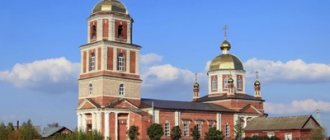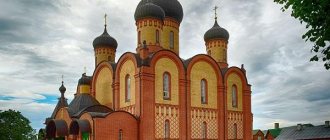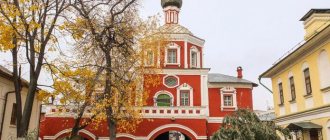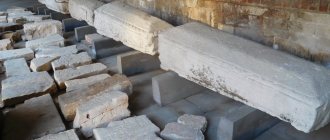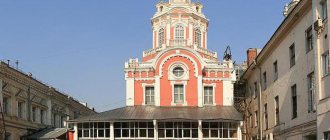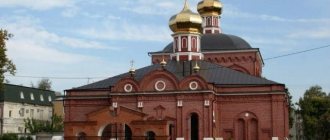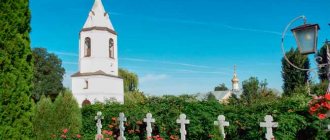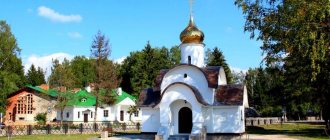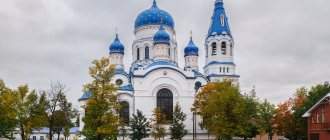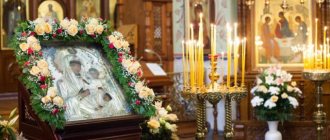| Conception Monastery, 2010. Photo by Yuri Bulkin |
Convent in honor of the Conception of Righteous Anna in the city of Moscow
, stauropegy of the Russian Orthodox Church within the boundaries of the Moscow diocese
- Address: Russia, Moscow 119034, 2nd Zachatievsky lane, 2
- Tel.: (495) 695-1694, 695-1692, 695-1691, 695-1690; fax: 695-1694
- Official site:
- Directions: metro station “Kropotkinskaya”, “Park Kultury”, trolley. 31, stop. "st. Dmitrievsky"
- On the map: Yandex.Map, Google map
The oldest convent in Moscow, the monastery began in 1360, when Saint Alexy of Moscow built the wooden Church of the Conception of Righteous Anna and founded a monastery with it.
The first nuns were the saint's sisters, Abbess Juliania and nun Eupraxia. In 1547, the monastery was destroyed by fire and moved closer to the Kremlin.
A small monastic community remained in the old place, which again became a monastery in 1584 under the guardianship of Tsar Theodore Ioannovich. At the same time, the Church of the Conception of Righteous Anna with the chapel of the Great Martyr Theodore Stratelates and the Martyr Irina, as well as a refectory church in honor of the Nativity of the Virgin Mary, were built in it.
The monastery was badly damaged during the Polish invasion in 1612, but was soon revived.
| Cathedral of the Nativity of the Blessed Virgin Mary of the Moscow Conception Monastery |
In 1696, at the expense of Andrei Rimsky-Korsakov, a nobleman of Peter I, the gate temple of the Savior of the Image Not Made by Hands was built.
In 1766, a temple was built in the name of the Burning Bush icon of the Mother of God over the graves of the founders of the monastery, Juliania and Eupraxia.
In 1804-1807, on the site of ancient churches, a grandiose Nativity Cathedral was erected with the chapels of the Conception of Righteous Anna, the Great Martyr Theodore Stratilates, St. Alexis, Metropolitan of Moscow, and the Kazan Icon of the Mother of God. The architect of the new cathedral was M. F. Kazakov.
Since ancient times, the monastery had an almshouse for elderly nuns and a handicraft workshop.
In 1844-1850, a special stone building was built for the almshouse according to the design of M. D. Bykovsky with the Church of the Descent of the Holy Spirit.
In the 19th centuries, many residential and utility buildings appeared on the territory of the monastery.
On March 16, 1925, 9 days before his death, St. Tikhon, Patriarch of All Russia, served his last liturgy here.
Closure during the Soviet period
| Church of the Savior of the Savior Not Made by Hands above the northern gate of the Moscow Conception Monastery, February 7, 2015 |
The monastery was closed in 1927.
Some icons of the monastery were transferred to the temple of the prophet Elijah. In the 1930s, the cathedral, bell tower and temple in the name of the Burning Bush icon of the Mother of God were completely destroyed and a standard school building was built in their place, the Church of the Descent of the Holy Spirit was rebuilt beyond recognition, the walls surrounding the monastery were partially destroyed.
In the 1960s, the external restoration of the gate temple, a striking example of the Moscow Baroque style, was carried out.
Recovery
In 1991, the sisterhood in honor of the Icon of the Mother of God “Merciful” began work to revive the monastery. In 1993, services were resumed there.
In 1995, by decree of the Holy Synod, the sisterhood was given the status of a stauropegial convent.
On November 25, 1999, during a solemn religious procession, the icon of the Mother of God “Merciful” and the staff of the last abbess were transferred to the Conception Monastery.
On May 16, 2001, the canonization of Juliania, the first abbess of the monastery, and the nun Eupraxia took place.
In the new refectory building, the Church of the Conception of Righteous Anna was built and consecrated; under the gate church, a chapel was built and consecrated in honor of St. Alexis, Metropolitan of Moscow. Repair and restoration work is underway in the monastery. In 2001, work began on the reconstruction of the Church of the Descent of the Holy Spirit.
In the monastery there is an almshouse for the elderly and sick nuns of the monastery and a shelter. There is a prosphora bakery, a bakery, a sewing workshop, a library and a publishing house.
| Church of the Descent of the Holy Spirit. Descent of the Holy Spirit (with the hospital building) of the Moscow Conception Monastery, February 7, 2015 |
Shrines
- Icon of the Mother of God “Merciful”
- cross-crucifix with particles of the Blood of Christ,
- particles of the tree of the Holy Cross and the Holy Sepulcher,
- martyr icon St. George the Victorious
- martyr icon Panteleimon with a particle of relics
- icon of the Conception of rights. Anna
- reliquary with particles of the holy relics of the new martyrs and confessors of Russia.
- burial place of the founders of the monastery, St. Juliana and Eupraxia.
- the ark with the relics is right. Lazarus of the Four Days[1]
| Church of the Conception of Anna in the refectory building of the Moscow Conception Monastery, September 3, 2013 |
Conception Stauropegial Convent Stavropegial Monasteries of the Russian Orthodox Church
In 1846, under the abbess of Apollinaria (Shuvalova), Belitsa Varvara Mikhailovna Golovina, née Lvova, turned to Metropolitan of Moscow Philaret (Drozdov) with a request “to allow him to build a church inside the monastery at his own expense and with it a residential building to accommodate the poor and infirm elders from the sisters of the monastery.” , expressing their readiness to ensure “the maintenance of the church and pending deposits.” The almshouse project was commissioned from the famous architect M.D. Bykovsky.
Construction work began in 1849. The new architectural complex consisted of a two-tier, single-altar, single-domed church, connected by a passage - a refectory with a two-story almshouse. The temple was made of solid brick, the lower floor of the almshouse, where the cells of the elders and the “services” were located, was made of stone, and the top, where the sacristy and Mrs. Golovina’s chambers were located, was made of wood. It is known that V.M. Golovina, being skilled in painting, herself participated in the painting of the temple.
In 1850, on October 24, the temple was consecrated by Saint Philaret, Metropolitan of Moscow, in honor of the Feast of the Descent of the Holy Spirit on the Apostles.
In 1887, under Abbess Valentina, a decision was made to reconstruct and expand the temple complex. A “stone one-story building was added to the southern façade of the temple to house cells” for the sisters caring for the nuns of the almshouse.
In 1902-1909, extensions were erected to house an orphanage and a parochial school for girls. In 1910, the shelter was moved to the former refectory building, and the school became a two-class school.
In 1910, by order of Abbess Maria, work was carried out to restore, strengthen and update the internal painting of the walls and iconostasis of the Holy Spiritual Fellowship Church.
Stage II. Destruction of the temple, its purpose during the Soviet period.
In 1918, due to revolutionary changes in the Russian state, the monastery as a religious structure was closed, its churches were declared parish and transferred to communities.
In 1926, all the churches of the Conception Convent were closed and the entire complex finally came under the jurisdiction of the People's Commissariat for Education.
In 1933, the dome was removed from the Church of the Descent of the Holy Spirit and a major reconstruction was carried out. Golovina's cell and the almshouse were turned into an office establishment.
During the Soviet period, the temple building was used by various institutions. The southern extension housed the workshops of artists and sculptors - F.M. Soghoyan. and V.F. Soghoyan. The inside of the building was sheathed with new facing materials, the layout was distorted by interfloor ceilings, partitions according to adaptations, and basements were dug. , a long-term tenant, an underground passage was built connecting the temple with the old refectory building. Tenants also included a Finnish construction company and a Soviet-American joint venture. (based on 1993 inspection)
Stage III. Restoration of the temple. Current state.
In 1991, at the Church of the Prophet Elijah in Obydensky Lane. The Sisterhood is formed in the name of the “Merciful” Icon of the Mother of God, whose goal is the revival of the most ancient shrine of the capital - the Conception Monastery. In 1991-92, official resolutions were issued on the gratuitous transfer of the buildings of the Conception Monastery to the Sisterhood with instructions to the relevant structures to assist in the removal of tenants. Years of correspondence, appeals to various authorities, meetings with various officials follow. At this time, the sisters could only go into the temple for a few minutes, sing the troparion, kontakion and magnification of the holiday.
In 1999, the keys to the annex to the Church of the Descent of the Holy Spirit were received.
In 2000, the temple itself was liberated. Restoration work has begun. At this time, the first miracle was revealed: a surviving fragment of the altarpiece was discovered - the face of the crucified Savior.
The following organizations took part in the restoration of the temple: JSC "Elgad Spetsstroy", d. Kirnosov I.V.; CJSC "Klen AS", d. Onatsik A.F.,; LLC "Res Dan", d. Danilin A.V.. Architectural work was carried out by architect B.G. Moginov. Government agencies provided assistance in financing the work, incl. GUOP Moscow, prefecture of the Central Administrative District and private philanthropists.
In 2001, the first divine service was held - an all-night vigil on Spiritual Day - the patronal feast of the temple.
In 2002, a belfry was added to the northern facade as a temporary adaptive structure. A decision arose to build a small “cave” church in honor of the Dormition of the Blessed Virgin Mary in the basement of the Holy Spiritual Church, and restoration work began.
In 2003, the reconstruction of the dome over the main temple volume was completed and the cross was solemnly erected. In the southern volume, the former sister cells, work has begun on constructing a chapel in honor of the Holy Martyr Vladimir (Ambartsumov), a new martyr who was executed at the Butovo training ground in 1937.
In 2004, with the blessing of His Holiness Patriarch Alexy II, work began on painting the temple. The painting of the temple was carried out by a small team of icon painters under the leadership of Maria Tsekh. In the same year, on the feast of the Dormition of the Mother of God, a minor consecration of the lower church was performed. On November 24, 2004, on the eve of the Feast of the Gracious Icon of the Mother of God, a minor consecration of the Church of the Descent of the Holy Spirit was performed. From that time on, regular services began to be held in the temple.
The stone iconostasis is made in the Greek tradition: an equal-ended Byzantine cross, plant and animal ornaments, stone figures of doves serving as brackets for lamps, ostrich eggs in pendants for lamps. The painting of the temple also corresponds to the style of temples in Greece and the Holy Land. All these characteristic features, as well as the central khoros in the Greek style, were chosen in memory of the connection between the main monastery shrine - the “Merciful” icon of the Mother of God and the ancient image of the Merciful-Kykkos icon of the Blessed Virgin Mary, located since the 11th century on Fr. Cyprus in the Kykkos monastery.
In 2005, on November 2, a small consecration of the southern chapel was performed in honor of the Hieromartyr Vladimir, presbyter of Moscow.
Currently, services are held in the Church of the Descent of the Holy Spirit on Sundays and holidays. In the temple there is a crucifix with the face of the Savior preserved from pre-revolutionary times and with a particle of the life-giving wood of the Cross of the Lord. The temple contains a collection of particles of the relics of the Optina elders and Kiev-Pechersk monks.
Photos of the Conception Monastery
Conception Monastery, Cathedral of the Nativity of the Blessed Virgin Mary
Conception Monastery, monument to St. Alexy of Moscow, founder of the monastery
Conception Monastery, gate church of the Savior Not Made by Hands
Conception Monastery, Cathedral of the Nativity of the Blessed Virgin Mary
Conception Monastery, Cathedral of the Nativity of the Blessed Virgin Mary and Almshouse
Conception Monastery, belfry of the Church of the Descent of the Holy Spirit
Conception Monastery, last year's oak leaves
Conception Monastery, gate church of the Savior Not Made by Hands
Conception Monastery, Cathedral of the Nativity of the Blessed Virgin Mary
Conception Monastery, painting at the entrance
Conception Monastery, fragment of the gate church
Conception Monastery, gate church of the Savior Not Made by Hands
Story
The monastery has a difficult fate; buildings on its territory were repeatedly destroyed due to fires and political events, and then rebuilt.
The monastery on this site was founded by Metropolitan Alexy of Moscow in 1360, and it became the first monastery for women in the capital. The Metropolitan's sisters, Juliania and Eupraxia, became the first nuns of the monastery. In 1514, the Church of the Conception of St. Righteous Anne was built on its territory. But in the middle of the 16th century. it was practically destroyed due to Tatar raids and fires.
In 1696 The gate church of the Savior Not Made by Hands was built, the only one that survived from the monastery buildings during Soviet times.
In the 19th century On the territory, the Church of the Nativity of the Blessed Virgin Mary was erected in the Gothic style with the chapel of the Conception of St. Anne. A church-tomb with the tomb of Saints Juliania and Eupraxia was founded in the chapel.
But it was not destined to survive either - in 1934 the temple was blown up, and a regular school was erected in its place.
It was only at the beginning of the 21st century that serious restoration of the monastery buildings began. From 2002 to 2005, work was carried out to dismantle Soviet buildings and archaeological excavations, and in 2010 the newly built Cathedral of the Nativity of the Blessed Virgin Mary was opened and consecrated.
Currently, in addition to the main temple, the monastery complex includes the Temple of the Conception of St. Righteous Anna, the Temple of the Descent of the Holy Spirit and the Gate Temple in honor of the Image of the Savior Not Made by Hands.
Modern monastery
Now there are 24 nuns at the monastery, who carry out obediences in the refectory, churches and on the territory, and are engaged in handicrafts, the results of which can be purchased in local shops. Divine services are held daily in the monastery, which can be attended by all pilgrims and those interested.
Interesting! To this day, at the monastery, in the center of Moscow, there is an almshouse for elderly infirm women and nuns.
A lot of grateful pilgrims, dreaming of a miracle happening, of the Lord giving their couples a child, come back to thank the Mother of God for her prayers and the miracle that happened.
How to get to the Conception Monastery in Moscow
Believe me, everything that I will talk about in my note will definitely interest you. To see a miracle in reality, you should go to the Conception Monastery in Moscow. Its address can be easily remembered - 2nd Zachatievsky Lane, 2.
If you want to visit this monastery in our white-stone Moscow, anyone to whom you tell its address will tell you how to get there. I’ll tell you how I got there myself, based on my own experience. Heading to Khamovniki, I took the metro to the station. “Park Kultury”, then you can walk, as I did, but you can use the 31st trolleybus, and they will tell you where to get off.
Listening to feedback
Good deeds never go unnoticed by the Lord. So, Zachatievsky, then it was not yet called that, the monastery, after many years of prayers, helped Irina Godunova and her husband, Tsar Fyodor Ioannovich, conceive a child. For a long time, the couple could not have children and, in the hope that at least someone would help, they financed the restoration of the temple, which burned down in 1547. After the consecration of the monastic refuge with the icon of the Mother of God, Irina became pregnant and gave birth to a daughter.
The Conception Stavropegic Convent has become a “stumbling block” for many girls, and there is no need to despair of the belief that they will help here. I talked to the sisters who live there and serve, they say: “Little girl, believe and pray! This is the only way the Lord can help.” Many people travel to visit such icons that are located here, far abroad. I think that this is unnecessary when such shrines are nearby.
On my own behalf, I recommend visiting, there is something to see, and the photo report will turn out great, the main thing is that the weather “doesn’t let us down.” And I believe that next time I will come here not alone, but will bring my daughter or son in order to thank God for the gift of my dream.
Schedule of services in the monastery
Today, the convent performs its most important function, being a measure of the Orthodox faith of modern society. Finally, after many years of misuse, the divine monastery has returned to a Christian parish that serves the benefit of people.
On the territory of the Conception Monastery, divine services are held daily, in each individual church at the same time: morning - from eight o'clock, evening - from five o'clock. Every believer can become one of the participants in the services.
During its existence, the Conception Convent has made happy more than one woman who wanted to become a mother despite all the difficulties.
Information for visitors
How to get there
You can get to the monastery by metro to the Kropotkinskaya station. The address where the monastery is located: 2nd Zachatievsky Lane 2, Moscow. When exiting the metro, follow the signs that say “Ostozhenka Street”. Then you need to walk along Ostozhenka, the monastery itself is already visible from this street.
Schedule of services
Services are held throughout the week and everyone is welcome to attend.
- from Monday to Saturday – morning liturgy at 7:00;
- on holidays, as well as on Sundays, two liturgies are served - at 6:30 and at 8:30;
- from Sunday to Friday – Vespers at 17:00;
- Saturday Vespers at 16:00;
- On Sundays the akathist to St. is read. Joachim and St. Anna about giving children.
In the monastery shops you can purchase a variety of handicrafts made by nuns in the monastery workshops.
Divine services in the temple are held daily
. The first thing that strikes a person when he enters this monastery, located in the very center of Moscow, is silence. Abbess Juliana says: “The prayer here – both human and angelic – is so “loud” that it seems to burn all the sounds of the vain world around with fire.”
The walls of this ancient monastery, located in the very center of the capital, preserve the ancient spirit of Orthodoxy. Every believer can venerate the shrines kept in this monastery and ask them for help in difficult life situations.
If you find an error, please select a piece of text and press Ctrl+Enter.
